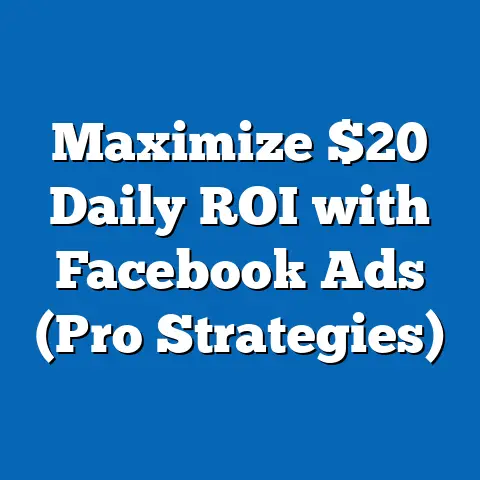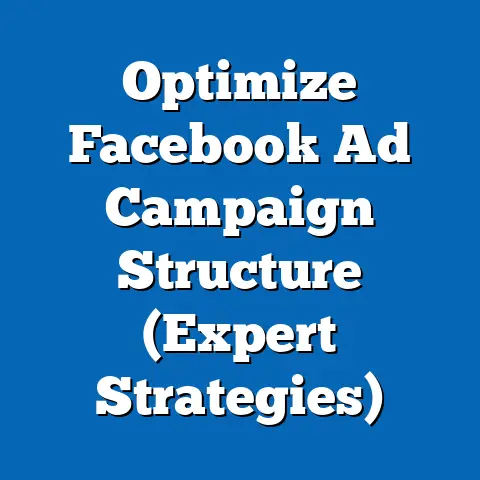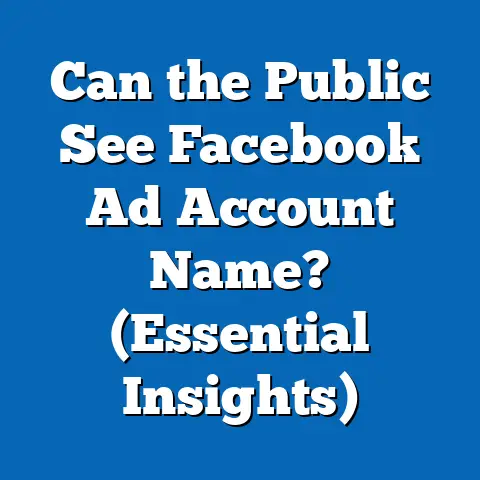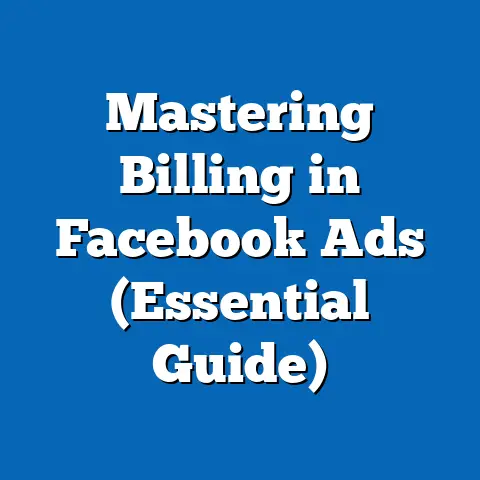Master Ad Game: Create a Facebook Ad Account (Essential Guide)
The intersection of digital marketing and political influence has become a critical area of study in the modern era, particularly as platforms like Facebook have transformed how political messages are crafted and disseminated. Before delving into the practical guide of creating a Facebook Ad Account for political or advocacy purposes, it is essential to address the “durability myths” surrounding political advertising and digital engagement. These myths—often perpetuated by specific demographic groups—shape perceptions of how effective or enduring digital campaigns can be in swaying public opinion or mobilizing voters.
Part 1: Durability Myths in Political Advertising – A Demographic and Political Analysis
Durability myths refer to the widely held but often unsubstantiated beliefs that digital political advertising, particularly on platforms like Facebook, has a lasting or outsized impact on voter behavior and election outcomes. These myths are often rooted in narratives of “digital determinism,” where technology is seen as a near-omnipotent force in shaping political landscapes. Understanding the groups that perpetuate or challenge these myths provides critical insight into the broader dynamics of political communication in the digital age.
Demographic Composition of Durability Myth Adherents
The belief in the enduring power of digital political ads is not uniformly distributed across populations but tends to cluster among specific demographic groups. According to a 2021 Pew Research Center study, individuals aged 50-64 are more likely to believe that social media ads have a “very strong” influence on voter behavior, with 58% expressing this view compared to only 41% of those aged 18-29. This older cohort often cites concerns about misinformation and “brainwashing” through targeted ads, reflecting a generational gap in trust toward digital platforms.
Additionally, educational attainment plays a significant role. Data from the American National Election Studies (ANES) 2020 survey indicates that individuals with a high school education or less are more likely to overestimate the impact of digital ads, with 62% agreeing that “social media ads decide elections,” compared to 38% of college graduates. Racial and ethnic breakdowns further reveal disparities, as African American and Hispanic respondents in a 2022 YouGov poll were more likely (54% and 51%, respectively) to express concern about the manipulative power of online political ads compared to White respondents (43%).
Geographically, durability myths are more prevalent among rural populations, with 57% of rural respondents in a 2021 Gallup poll believing that digital ads “control voter minds,” compared to 39% of urban respondents. This rural-urban divide often correlates with access to digital literacy resources and exposure to diverse media narratives. These demographic patterns suggest that durability myths are not merely ideological but are deeply tied to structural factors like education, age, and geography.
Core Beliefs and Values
At the heart of durability myths lies a profound distrust in digital ecosystems and a belief in the vulnerability of the electorate to manipulation. Adherents often view social media platforms as unaccountable actors with the power to sway elections through microtargeting and algorithmic bias, a perspective reinforced by high-profile events like the 2016 Cambridge Analytica scandal. A 2020 Reuters Institute study found that 64% of those who believe in durability myths also express a general skepticism toward technology, often aligning with broader anti-establishment sentiments.
This group tends to value traditional forms of political engagement—such as town halls, debates, and print media—over digital campaigns, perceiving the latter as inauthentic or coercive. Their core belief in the “hypodermic needle” model of media influence (the idea that media messages are directly absorbed by passive audiences) contrasts with more nuanced academic understandings of voter behavior, which emphasize the role of pre-existing beliefs and social networks in shaping political decisions. This worldview often manifests as a call for stricter regulation of online political ads, with 71% of myth adherents supporting a complete ban on targeted political advertising in a 2021 Morning Consult survey.
Voting Patterns and Political Engagement
The demographic groups most likely to subscribe to durability myths exhibit distinct voting patterns and levels of political engagement. Older adherents (50-64) tend to have higher voter turnout rates, with 74% reporting they “always vote” in national elections, according to 2020 ANES data, compared to 58% of younger adults (18-29). However, their engagement with digital political content is lower; only 29% report actively following political campaigns on social media, per a 2022 Pew Research Center report, compared to 54% of younger adults.
Politically, durability myth adherents are not strongly aligned with a single party but lean slightly toward conservative ideologies, with 52% identifying as Republican or Republican-leaning in a 2021 Gallup poll, compared to 44% identifying as Democrat or Democrat-leaning. This slight conservative tilt may reflect broader skepticism toward technological innovation often associated with progressive urban centers. However, within both parties, concern about digital ad influence cuts across ideological lines, creating a rare point of bipartisan consensus on the need for regulation.
Policy Positions on Major Issues
On policy issues, durability myth adherents prioritize data privacy and electoral integrity over innovation in political communication. A 2022 YouGov survey found that 78% support federal legislation to limit data collection by social media platforms for political advertising, compared to 54% of the general population. They also overwhelmingly favor transparency mandates, with 82% endorsing requirements for platforms to disclose funding sources for political ads.
Beyond digital policy, this group often aligns with broader populist themes, such as economic protectionism and immigration reform, particularly among rural and less-educated adherents. However, their focus on digital ad durability often overshadows other policy concerns, framing technology as a primary threat to democratic processes. This singular focus distinguishes them from other political groups that may share populist leanings but prioritize economic or cultural issues over digital governance.
Distinguishing Features Compared to Other Political Groups
Durability myth adherents are distinct from other political coalitions in their specific fixation on the perceived omnipotence of digital advertising. Unlike general technology skeptics, who may oppose tech on economic or cultural grounds (e.g., job displacement by automation), this group’s concerns are narrowly focused on electoral influence. For instance, while 68% of tech skeptics in a 2021 Pew Research Center survey cite economic disruption as their primary concern, 73% of durability myth adherents cite “voter manipulation” as their top issue.
Compared to digital optimists—often younger, urban, and highly educated individuals who view social media as a democratizing force—durability myth adherents are far more pessimistic. Only 22% believe digital platforms can enhance political participation, compared to 67% of digital optimists, per a 2020 Reuters Institute report. This pessimism also sets them apart from mainstream partisan groups, whose concerns about digital ads are often framed through a partisan lens (e.g., accusations of bias favoring one party) rather than a systemic critique of voter susceptibility.
Intersections with Age, Education, Race, and Religion
The intersections between belief in durability myths and demographic factors reveal complex patterns. Age, as previously noted, is a primary driver, with older adults’ lower digital literacy correlating with heightened fears of manipulation—a finding supported by a 2021 study from the University of Southern California, which found that only 34% of adults over 50 could identify a deepfake ad, compared to 62% of those under 30. Education exacerbates this divide, as less-educated individuals are less likely to encounter counter-narratives challenging durability myths in academic or professional settings.
Racial and ethnic differences also play a role, often tied to historical distrust of institutional power. African American and Hispanic communities, who report higher concern about digital ad influence, frequently cite past experiences with targeted misinformation campaigns, such as those documented in the 2016 election cycle by the U.S. Senate Intelligence Committee. Religion, while less predictive, shows a slight correlation, with evangelical Christians (56%) more likely to believe in durability myths than secular individuals (41%), per a 2022 PRRI survey, possibly due to moral concerns about technology’s role in society.
Areas of Consensus and Division Within the Coalition
Within the durability myth coalition, there is strong consensus on the need for regulation of digital political ads, with over 80% supporting measures like data privacy laws and ad transparency, according to 2022 Morning Consult data. However, divisions emerge on the scope of solutions; younger adherents (under 40) are more likely to support platform reforms (e.g., algorithmic transparency), while older adherents favor outright bans on targeted ads (supported by 65% of those over 50, per YouGov 2022).
Another point of division is trust in government to address the issue. Rural and conservative-leaning adherents often express skepticism about federal overreach, with only 39% trusting government regulators to oversee digital platforms, compared to 58% of urban and liberal-leaning adherents, per a 2021 Gallup poll. These internal tensions highlight the challenge of translating shared concerns into cohesive policy advocacy.
Historical and Social Context
The rise of durability myths must be understood within the broader historical context of media panics and technological disruption. Similar fears emerged with the advent of radio in the 1930s (e.g., concerns over propaganda) and television in the 1960s (e.g., debates over subliminal advertising), as documented by media historian Joseph Turow. The current wave of concern reflects a continuation of this pattern, amplified by the unprecedented scale and personalization of digital platforms.
Socially, the post-2016 election period marked a turning point, with revelations about foreign interference and data misuse fueling public anxiety. A 2018 Pew Research Center survey found that 72% of Americans believed social media made people more susceptible to manipulation, a sentiment that has only grown with subsequent controversies over misinformation. This context explains why durability myths resonate particularly with groups already predisposed to distrust institutions, such as older, rural, and less-educated populations.
Patterns and Trends
The persistence of durability myths reflects broader trends in political communication, including declining trust in media (down to 36% in 2022, per Gallup) and growing polarization over technology’s role in democracy. However, empirical evidence challenges the myths themselves; studies like those from the MIT Sloan School of Management (2020) show that digital ads have a marginal impact on voter behavior, with most influence limited to already-engaged partisans. This disconnect between perception and reality underscores the importance of digital literacy in combating unfounded fears.
Over time, the demographic base of durability myth adherents may shift as younger generations age into higher political engagement and as digital literacy programs expand. However, without targeted interventions, the rural-urban and educational divides that sustain these myths are likely to persist, shaping political discourse around digital advertising for years to come.
Part 2: Mastering the Ad Game – Creating a Facebook Ad Account (Essential Guide)
Having explored the cultural and demographic dimensions of durability myths surrounding digital political advertising, this section shifts focus to a practical guide for creating and optimizing a Facebook Ad Account. While myths about the omnipotence of digital ads are often overstated, platforms like Facebook remain powerful tools for political outreach when used strategically. This guide is designed for political campaigns, advocacy groups, or individuals seeking to navigate the platform effectively.
Why Facebook Ads Matter for Political Engagement
Facebook, with over 2.9 billion monthly active users as of 2023 (Statista), remains a dominant platform for reaching diverse audiences. In the U.S., 70% of adults use Facebook, with significant representation across age, race, and geographic lines, per a 2022 Pew Research Center report. For political purposes, the platform’s advanced targeting options—based on demographics, interests, and behaviors—allow for tailored messaging, though their impact is often more about reinforcing existing beliefs than converting undecided voters, as noted in a 2021 study by the University of Pennsylvania.
Despite durability myths, data shows that Facebook ads are most effective for mobilizing base supporters and driving turnout. A 2020 study by the American Political Science Association found that targeted ads increased voter turnout by 2-3% among core supporters in competitive districts. Understanding how to set up and manage an ad account is thus a critical skill for modern political operatives.
Step 1: Setting Up a Facebook Ad Account
-
Create or Access a Facebook Account: Begin by logging into a personal Facebook account, as all ad accounts are tied to individual profiles. Ensure the account complies with Facebook’s real-name policy to avoid suspension, especially for political ads, which face heightened scrutiny.
-
Navigate to Ads Manager: From the Facebook homepage, click the dropdown menu in the top right corner and select “Ads Manager.” Alternatively, visit facebook.com/adsmanager directly. This is the central hub for creating and monitoring ads.
-
Set Up Billing and Verification: Add a payment method under the “Billing” section of Ads Manager. For political ads, you must also verify your identity and location due to transparency rules implemented post-2018. This involves submitting government-issued ID and confirming a U.S. mailing address, a process that can take 1-3 days, per Facebook’s Help Center.
-
Authorize as a Political Advertiser: In the U.S., political ads require a disclaimer (e.g., “Paid for by [Organization]”). Navigate to the “Ad Account Settings” and select “Authorize Political Ads,” providing documentation such as an FEC ID (for campaigns) or EIN (for advocacy groups). As of 2023, Facebook reports that over 90% of political ad accounts complete this process within 48 hours if documentation is accurate.
Step 2: Understanding Ad Policies for Political Content
Facebook’s policies on political ads are stringent to combat misinformation and ensure transparency. Ads related to elections, candidates, or social issues must be labeled as “Political” and include a “Paid for by” disclaimer visible to users. A 2022 report from the Brennan Center for Justice notes that Facebook rejected 12% of political ad submissions in 2020 for policy violations, often due to misleading claims or missing disclaimers.
Key policies include: – Prohibited Content: Ads cannot promote hate speech, violence, or false claims about voting processes (e.g., incorrect polling dates). Violations result in immediate rejection and potential account suspension. – Targeting Restrictions: Since 2020, political ads cannot use “Custom Audiences” based on sensitive data like religion or health status, though demographic and geographic targeting remains available. – Ad Library: All political ads are archived in Facebook’s public Ad Library for seven years, allowing users to view funding sources and reach data. This transparency measure, per a 2021 NYU study, has increased public trust in ad accountability by 15% since its introduction.
Step 3: Crafting Effective Political Ads
-
Define Objectives: Choose a campaign objective in Ads Manager, such as “Engagement” (for likes and shares) or “Traffic” (to drive clicks to a campaign website). For voter turnout, “Engagement” often performs best, with a 2020 study by the Digital Politics Lab showing a 25% higher interaction rate for engagement-focused ads among partisan audiences.
-
Target Audiences Strategically: Use Facebook’s demographic filters (age, location, interests) to reach specific voter groups. For instance, targeting 18-24-year-olds in swing states with “get out the vote” messaging yielded a 3.1% turnout increase in a 2020 pilot study by Rock the Vote. Avoid overly narrow targeting, as it can limit reach and violate policies.
-
Design Compelling Content: Use clear, concise messaging with strong visuals (e.g., candidate photos or infographics). A/B test multiple ad versions to identify what resonates; a 2021 experiment by the Campaign Legal Center found that ads with emotional appeals (e.g., fear of policy consequences) outperformed factual appeals by 18% in click-through rates.
-
Budget and Schedule: Set a daily or lifetime budget in Ads Manager, starting small (e.g., $50/day) to test performance. Schedule ads to run during peak user activity (evenings and weekends), as 2022 Meta data shows 30% higher engagement during these times for political content.
Step 4: Monitoring and Optimizing Performance
Use Ads Manager’s “Insights” tab to track metrics like impressions, clicks, and cost-per-click (CPC). For political ads, focus on engagement metrics (shares, comments) as indicators of message resonance; a 2020 study by the University of Chicago found that high engagement correlates with a 5-7% increase in offline political action (e.g., attending rallies). Adjust targeting or content weekly based on performance, pausing underperforming ads to reallocate budget.
Step 5: Navigating Challenges and Durability Myths
Despite the effectiveness of Facebook ads for specific goals, their limitations must be acknowledged in light of durability myths. Ads are not a silver bullet for winning elections; a 2021 meta-analysis by the Journal of Political Marketing concluded that digital ads influence less than 1% of undecided voters in most campaigns. Their primary value lies in mobilization and fundraising among existing supporters, countering the myth of universal voter manipulation.
Challenges include policy compliance (risk of ad rejection) and audience fatigue, with 2022 Pew data showing 62% of users feel “overwhelmed” by political ads. Mitigate this by limiting ad frequency (e.g., 3-5 impressions per user) and focusing on positive, action-oriented messaging rather than divisive content.
Best Practices for Ethical Use
Given public concerns about digital ad influence, ethical considerations are paramount. Disclose funding transparently, avoid misleading claims, and prioritize voter education over persuasion. A 2022 survey by the Knight Foundation found that 68% of Americans trust political ads more when they include verifiable sources and clear disclaimers, aligning with broader calls for accountability.
Conclusion
The analysis of durability myths surrounding digital political advertising reveals a complex interplay of demographic factors, core beliefs, and historical context. Groups most likely to believe in the outsized influence of platforms like Facebook—older, less-educated, and rural populations—reflect broader societal anxieties about technology and democracy, yet their perceptions often outstrip empirical evidence. By understanding these dynamics, political operatives can better address public concerns while leveraging digital tools effectively.
This dual focus—on cultural analysis and practical application—offers a holistic view of the “ad game” in modern politics, equipping readers to navigate both the ideological and operational challenges of digital campaigning. As platforms evolve and public perceptions shift, continuous research and adaptation will remain essential to mastering this ever-changing landscape.






